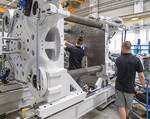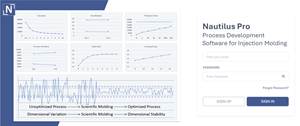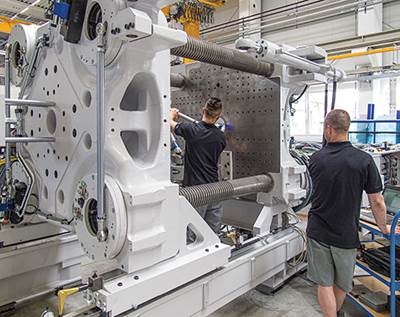INJECTION MOLDING: How to Specify an Injection Molding Machine
In part two of a three-part series, the focus is on the injection unit.
With the market percolating, more molders are looking at new presses. This is the second in a series of three on what you need to know and do to specify a machine that is best for your needs. In Part 1 we covered the clamp. Here, we turn our attention to the injection unit.
As stated last month, the economic upturn is bringing the injection molding manufacturing market along for the ride. Demand for molded parts has risen, and in response many molders are upgrading or expanding their plants. This has increased demand for new machines. Lead times are long and you need to have a plan.
If you missed it, here’s a recap of the major points from Part 1:
• Try not to buy a machine on the spur of the moment.
• Have a retirement plan for your equipment.
• Develop a list of needs for the next machine even if money is not available or there is no money (or need) to purchase right now.
• Don’t settle for whatever is in inventory; specify what you need.
• Pay attention to the details, get the folks on the shop floor involved, and document what you need to the purchasing agent. Don’t get the purchasing manager involved in the specification process, as he or she will be singularly motivated by price. Follow the Deming principle: The people that use the equipment specify the equipment.
• Do not buy a machine for a single job; build in flexibility, because you do not know the future.
• To specify a machine, break it down into its component parts. Every mold is its own peculiar beast, so are the basic components of the machine. They are the clamp, injection unit, and controller. Each has its own function and must be specified to your requirements, or more specifically the requirements of your part.
Where the injection unit is concerned, here is a partial checklist of the criteria to review, things to remember, and questions to ask of both yourself and your potential machine builder(s) before issuing a purchase order:
1. Do you need hydraulic or electric screw rotation?
2. Do you need hydraulic or electric injection?
3. What screw/barrel size do you need? Order a size that will use 25-65% of its shot capacity for most of your jobs. I can hear you screaming already, but melt quality is critical and you need to follow the rules. If you cannot do this with just one barrel, buy a second one to cover all your jobs. They are reasonably priced when ordered with the machine. But do not buy the biggest barrel just because there is no price difference. And remember, standard machine specifications are usually for polystyrene; semi-crystalline resins like polypropylene require more volume. Check out the melt density of your intended resin(s) for that machine.
4. Can the barrel can be easily changed when hot, and does that take minimum time for the size of the machine?
5. Do not buy a general-purpose screw. As fellow columnist and extrusion expert Jim Frankland notes, they serve no purpose.
6. Are the screw and barrel built of the right metal for wear, chemical resistance, and temperatures likely to be used now and in the future?
7. Is the plasticating rate repeatable and sufficient for the quoted cycle? Remember, machine specification is usually for polystyrene.
8. Is the injection velocity load-compensated? That is critical for consistent processing.
9. Does the screw position drift during mold open or process interruption?
10. Can you profile velocity? Five steps is enough.
11. Will the machine provide velocities necessary for your current and future jobs? Will you need a high-speed machine in the future?
12. Does the machine need accumulators?
13. Is the velocity reproducible? See number 8.
14. Make sure the builder provides ΔP for proper velocity control.
15. Can the press transfer from first to second stage at setpoint at all velocities?
16. Does the machine have the appropriate velocity linearity?
17. Is the maximum nozzle melt pressure (also called injection or specific pressure) capable of making your parts, now and in the future? I recommend 30,000 psi (2070 bar). Know the
intensification ratio if the drive
is hydraulic.
18. Can the machine read out melt pressure?
19. Are there gauge ports available to
check hydraulic pressure at the pumps,
injection unit, and nozzle pull-in force?
20. Is second stage stable (±7 psi, 0.5 bar)?
21. Is the first-to-second-stage switchover time less than 0.10 sec? You don’t want a ramp or spike at switchover unless needed.
22. Is second-stage pressure repeatable?
23. Is switchover from first to second stage by time, position, hydraulic pressure, or cavity pressure? Is there a priority, such as “first-met” transfers?
24. Is recovery energy monitored (psi or amps x time)?
25. Is the backpressure constant and stable?
26. Is the PID temperature control auto-tuned?
27. Do the PID loops use an ambient reference?
28. Is the nozzle PID temperature controlled? Is the thermocouple one-third the distance along the nozzle body and tip, not in the hex nut or exposed? It should be a spade type, with no hole in the nozzle body.
29. Is the feed throat PID temperature controlled?
30. Do the automatic heater bands have fault detection?
31. Are heater bands and thermocouples of the plug-in type for easy calibration and replacement?
32. Are heater bands (but not the gap between them) insulated?
33. Do thermocouple wells have thermal paste inside to aid in temperature measurement?
34. Do you have cold-start protection?
35. Are oil temperatures controlled ± 5 oF (2.5 oC) if servo-valve equipped?
36. Does the oil preheat automatically at startup, and will the machine not run on automatic until oil is at operating temperature?
37. Can you mount the mold if the oil is not up to temperature?
38. Is the computer surge-protected with a battery backup? That’s a must due to power surges and the cost of replacement parts. You do it for your home computer, and this is much more expensive!
Next issue: Part 3: How to buy a controller.
Related Content
Use These 7 Parameters to Unravel the Melt Temperature Mystery
Despite its integral role in a stable process and consistent parts, true melt temperature in injection molding can be an enigma. Learning more about these seven parameters may help you solve the puzzle.
Read MoreOnline Versions of Process Development Course and Software Launch
NPE2024: FimmTech is introducing online versions of its Nautilus process development software as well as its Scientific Molding and Design of Experiments (DOE) process development course.
Read MoreRead Next
INJECTION MOLDING: How to Specify an Injection Molding Machine
With the market percolating, more molders are looking at new presses. This series will discuss what you should consider before writing a check, beginning with the clamping unit.
Read MoreSee Recyclers Close the Loop on Trade Show Production Scrap at NPE2024
A collaboration between show organizer PLASTICS, recycler CPR and size reduction experts WEIMA and Conair recovered and recycled all production scrap at NPE2024.
Read More
.jpg;width=70;height=70;mode=crop)










